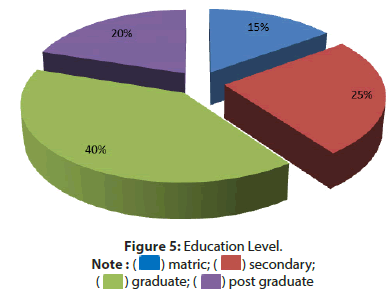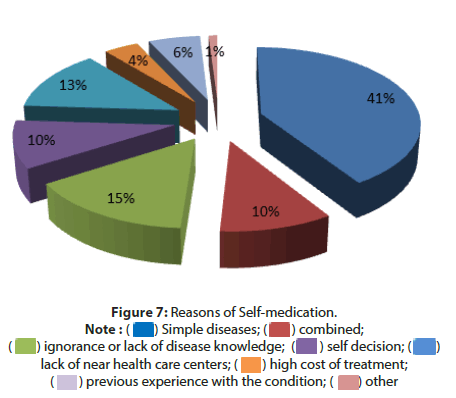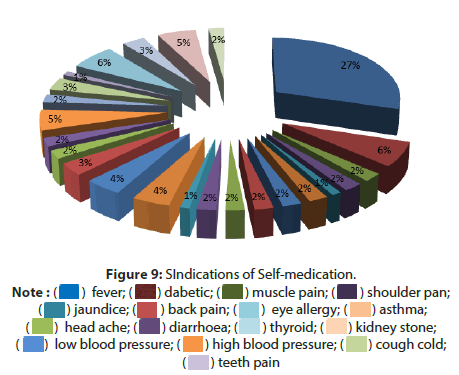Self-Medication: A Comparative Study of Medication Practice between Some Urban and Rural Working Professional at Shimla Hills Area
2 Department of Pharmaceutical Chemistry Maharaja Agarsen School of Pharmacy, Maharaja Agarsen University, Baddi, Solan, Himachal Pradesh, India
3 Department of Pharmacognosy, Maharaja Agarsen School of Pharmacy, Maharaja Agarsen University, Baddi, Solan, Himachal Pradesh, India
Received: 18-Aug-2021 Accepted Date: Sep 02, 2021 ; Published: 09-Sep-2021
Citation: Dutta D, Kumar A, Preeti A, et al. A Self-Medication: A Comparative Study of Medication Practice between Some Urban and Rural Working Professional at Shimla Hills Area. J Basic Clin Pharma 2021;12(6):67-70.
This open-access article is distributed under the terms of the Creative Commons Attribution Non-Commercial License (CC BY-NC) (http://creativecommons.org/licenses/by-nc/4.0/), which permits reuse, distribution and reproduction of the article, provided that the original work is properly cited and the reuse is restricted to noncommercial purposes. For commercial reuse, contact reprints@jbclinpharm.org
Abstract
Self-Medication practice is known as using multiple Over-The-Counter (OTC) drugs to treat your symptoms without physician aid, it is continuously increasing due to unawareness of health care system. Most OTC drugs are usually categorized into pain relievers, cough remedies, anti-allergens, laxatives, vitamins, antacids etc. This study was a community-based, cross-sectional survey carried out in some rural and urban area of Shimla Hills, Himachal Pradesh. To explore self-medication behavior among the general population, a direct interviews with respondents using a previously prepared questionnaire was done. In this study 300 (both male and female) respondents were investigated with age band of 20-60 years, study revealed that males were more prone towards self-medication practice than females. Fever, common cough and cold were the major class of disease associated with this practice. The main reasons for practicing self-medication was simple disease, previous experience with the same condition and considering the current condition uncomplicated with no need to consult a physician.
Keywords
Self-medication, OTC drugs, Antibiotic resistance
Introduction
In recent years there has been an increasing trend in self-medication practice in both developed and developing countries [1]. Self-medication is defined as the use of medication by a Patient on his own initiative or on the advice of a Pharmacist or a lay person instead of consulting a medical practitioner. Medicines for self-medication are often called nonprescription or Over The Counter (OTC) and are available without a doctor’s prescription through pharmacies. In some countries OTC products are also available in supermarkets and other outlets. Medicines that require a doctor’s prescription are called prescription products (Rx products). It is also defined as the use of drugs to treat self-diagnosed disorders or symptoms, or the intermittent or continued use of a prescribed drug for chronic or recurrent disease or symptoms [2]. Selfmedication is a current challenge especially in India, due to scarcity of health professionals. Adverse effects of this practice are worse than imagined. After repeated health awareness camps we are unable to deal with this situation.
In recent times of Covid-19 many patients. It was observed drugs like (Acetaminophen, Ibuprofen, Azithromycin, Penicillin, Anti-Retroviral and Hydroxychloroquine) were taken over the counter for various symptoms including: fever, fatigue, cough, sneezing, muscle pain, nasal congestion, sore throat, headache and breathing difficulty [3]. People were more scared about isolation that they were ready to compromise on their health along with their family members.
Difference between self-care and self-medication
Practicing self-medication in form of self-care of our health [4]. There is a huge difference between self-care and self-medication, taking health supplements without knowing the need of it is counted as self-medication only. Self-care is looking after you i.e. to be mentally, physically and socially fit. Self-care starts with good food, hygiene, active lifestyle, exercise and a peaceful environment. While on the contrary self-medication is to suppress common symptoms showed by our body by taking OTC drugs [5].
Sources of self-medications
In earlier time home-made remedies were the initial source of selfmedication Traditionally various herbs were taken to get relieved from the minor ailments. With new trends, friends, family, neighborhood and their previously prescribed medicines increase the rate of selfmedication. Also advancement in the media increased the source of selfmedication in the form of nutraceuticals, pain relievers and antacids etc. [6,7].
Reasons of self-medications
There are several reasons of self-medications
1. Lack of time: In this busy world where everyone is after job, money and family, health is taken lightly. Patients don’t have time to stand in long queue.
2. Education: People are aware of their problems and can easily analysis symptoms.
3. OTC drugs: As the practice of self-medication is increasing one can get antibiotics and pain killers very easily OTC without Doctor’s prescription.
4. Long working hours: Due to long working schedule both men and women are not able to visit doctor frequently.
5. Media and its awareness: Every disease state can be easily managed by taking information from media [8].
6. Online pharmacy: Online Pharmacy is the main source of selfmedication as we can get any drugs on cheaper rate without proper drug prescription. They provide cosmetics and multivitamins, sliming pills etc. which are not recommended by any healthcare professional.
Advantages of self-medication
1. Less burden on healthcare system
2. Remote area and hilly areas people can be benefitted by this practice.
3. Patients can easily get relieve from their ailments with immediate effects.
4. It is more cost effective and time saving.
Materials and Methods
It was a survey based study. In this study, 300 people were included. Both male and female were included in the study. Study period was from February 2019 to June 2019. A data collection paper was made in form of questionnaire and compiled all the information and data of the people in an organized manner. After that the collected data were entered into Microsoft Excel and then the result was shown in pie chart and calculated the percentage of the parameter of the awareness about self-medication.
Results and Discussion
There are various parameters which were assessed during this study starting from age, sex, area, income, education, occupation, and reasons for self-medications, source of self-medication, disease state and list of medicines used during self-medication.
Gender
During this study we have taken total 300 participants I which we had equal population of both the genders (Figure 1).
Area of distribution
Most of the participants belong to urban population around 55% i.e Solan, Shimla and Mandi and rest of the population i.e 45% belong to the rural population nearby villages of Solan and Shimla i.e Waknaghat, Shogi, Kandaghat and Mansar (Figure 2).
Comparison of urban and rural male and female
As above cited in total urban population there were around 65% male and 35% female while in rural population there were 45% male and 55% females (Figure 3).
Source of income per year
Source of income is the major factor for self-medication and we had divided the income strata i.e. between 50 k-1 lakh, 1 lakh-2 lakh, 2 lakh- 3 lakh and 3 lakh-4 lakh. On this basis we concluded that there were participants from every strata i.e 35%, 25%, 23% and 17% respectively (Figure 4).
Education level
Education is the main pillar to the self-medication, patients are more aware about each and every drugs prevailing. In this study we had divided the education level from Matriculation, Secondary, Graduation, and Post-Graduation. The data revealed that there were 15% participants were matric passed 25% were higher secondary, 20% were graduated and 40% were post graduated (Figure 5).
Occupation
Lack of time is counted as a major reason of self-medication so we had divided the participants on the basis of their occupation. So we had divided the professional as students, Helpers, Businessman and working professionals (who are doing 9 to 5 jobs). The data revealed that 35%,15%,20% and 30% participants in the study respectively (Figure 6).
Reasons of self-medications
There were various reasons of self-medications such as Simple disease like cough and cold, Ignorance or lack of disease knowledge i.e patients were not aware of the disease condition and took each symptoms lightly, Self-decision and diagnosis, Lack of near health care center, High cost of treatment, Previous experience with the condition most of them were having old prescriptions (Figure 7).
Source of drug information
Every person has a source of drug information which is the major issue for self-medication for eg. Retail pharmacy in India provide OTC drugs, Previous prescription, family and friends, other medical stuff, drug direction, mass media (Figure 8).
Conditions in which self-medication was done
Apart from major diseases there were self-medication for lots of diseases like fever, diabetic, muscle pain, shoulder pain, jaundice, back pain, eye allergy, headache, diarrhoea, kidney stones, high blood pressure, low blood pressure, tooth pain, migraine, scabies, hair fall, fungal infection, insomnia, uric acid (Figure 9).
Conclusion
This above study concluded that both males and females were involved in the viscous cycle of self-medication. We have concluded in the studies that their every patient with vivid age cycle is into these trends. People with different disease from normal cough to asthma and other deadly diseases patients are dependent on retail pharmacist and sometime on the relatives and friends.
More educated people were inclined towards self-medication practice but the use of antibiotics was very frequent for normal cough and cold, is a major issue of concern. Other major cause of self-medication was lack of time and poor health care system (lack of hospitals and doctors) which insists patients to visit retail pharmacy other than a specialized doctor. Last year of pandemic has taught us that self-care and precautions are more important than self-medication. But during these tariffing times people were more indulged in self-medications as antibiotics are not treated as a drug. This behavior will lead to a very difficult time and we are endangering our future generation as we will be at a high risk of antibiotics resistance. From the herbal tea to immunity booster the market is flooded with different types of drugs which everyone can easily get online as well as offline mode.
We can’t stop the trend of self-medication but by adding safer OTC drugs list we can help the patients from major ADRs and drug resistance. Moreover OTC drugs which is given to pregnant ladies and infants should be checked. A specialized person (Clinical Pharmacist) should always be available at Pharmacies to relieve patient stress with providing proper education to the patients. With increase in population the use of self-medication will increase so government should provide awareness camps regarding self-medication they should educate the people about medicine which is safe for normal use and which should be taken under physician advice. Our health care professionals are already overburden with the overcrowded Out Patients Department (OPDs) in our hospitals, by using drugs on a very frequent manner will lead to total failure of our system. Health care professionals such as doctor’s, specialized nurses, and clinical pharmacist can take up the challenge to reform self-medication.
REFERENCES
- Ali AN, Kai JT, Keat CC, et al. Self-medication practices among health care professionals in a Private University, Malaysia. Int Curr Pharm J.2012;1(10):302-310.
- Bowen D, Kisuule G, Ogasawara H, et al. Guideline for the regulatory assessment of medicinal products for use in self-medication. WHO.2000.
- Molina JM, Delaugerre C, Le Goff, et al. No evidence of rapid antiviral clearance or clinical benefit with the combination of hydroxychloroquine and azithromycin in patients with severe COVID-19 infection. Med Mal Infect.2020;50(4):384.
- Kayalvizhi S, Senapathi R. Evaluation of the perception, attitude and practice of self-medication among business students in 3 select cities, South India. IJEIMS.2010;1(3):40-44.
- Haider S, Thaver IH. Self-medication or self-care: Implication for primary health care strategies. JPMA.1995;45:297.
- Hernandez-Juyol M, Job-Quesada JR. Dentistry and self-medication: A current challenge. Med Oral Patol Oral Cir Bucal. 2002;7(5):344-347.
- Laporte JR, Catel JM. The physician and self-medication. Med Clin.1992;414-416.
- Jafari F, Khatony A, Rahmani E.Prevalence of self-medication among the elderly in Kermanshah-Iran. Glob J Health Sci. 2015;7(2):360.










